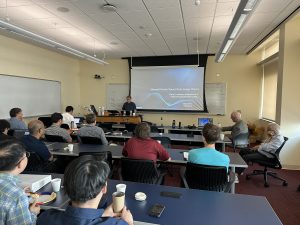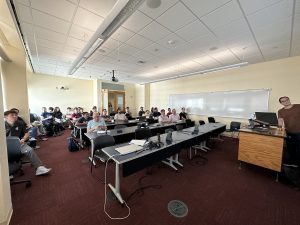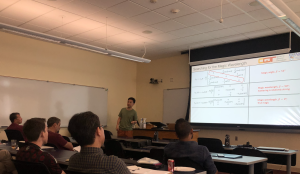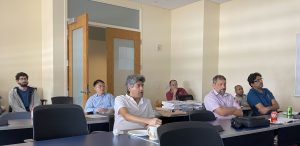Fall 2025
OPTICA student chapter seminar
Speaker: Saeed Rahmanian Koshkaki, Department of Chemistry, Texas A&M University
Title: Room Temperature Macroscopic Quantum Effects of Exciton-Polariton
Date: Thursday, November 20th (11.30 am)
Abstract: Strong light-matter coupling in an optical cavity induces light and matter hybrid quasi-particles known as exciton-polaritons. Exciton-polaritons possess exotic phenomena such as lasing, enhanced coherent transport, and room-temperature BEC. Previous theoretical studies of exciton-polaritons employ a simple description of the material where a one-dimensional single layer of exciton coupled with a phonon bath is placed in the middle of an optical cavity, which is in contrast with real-world experiments. To address this discrepancy, we develop a microscopic light-matter Hamiltonian along with an efficient mixed-quantumclassical approach to enable the simulation of exciton-polariton quantum dynamics in all three dimensions. Using this model, we studied exciton-polariton dynamics in a multilayered material in 3D optical cavities, and we introduced a light–matter moir´e effect (LMME) that arises when a 2D material is tilted inside a planar optical cavity. Our finding shows a drastic difference in exciton-polariton dynamics in single-layer and multilayer materials, and using geometric tilt LMME enables room temperature coherent frequency conversion and the emergence of exciton-polariton flat bands. On the other hand, a long-standing problem in exciton-polariton dynamics is the group velocity renormalization in the presence of exciton-phonon coupling. We develop an analytical, microscopic theory to describe polariton dispersion, formed by hybridizing excitons, photons, and phonons. Within our theoretical framework, phonons are treated as classical fields, which are then quantized via the Floquet formalism. We show that the entire polaron-polariton system can be described with a band picture despite the phonons breaking translational symmetry. Our work provides microscopic insights into the exciton-polariton dynamics and lays the foundation for future investigations of exciton-polariton dynamics that more closely reflect real-world experimental conditions. Our findings are of great importance for quantum information science and the development of polaritonic-based quantum technologies.
About the Speaker: Saeed Rahmanian Koshkaki is a postdoctoral researcher in the Department of Chemistry at Texas A&M University (TAMU). He received his PhD in physics from the University of Texas at Dallas (UT Dallas) in 2022, where his research focused on the study of many-body localization and topological phenomena in cavity QED systems. After completing his PhD, he held a researcher and lecturer position at UT Dallas before joining TAMU in 2024. Saeed Rahmanian Koshkaki’s research spans condensed matter theory, quantum optics, and quantum information science. A major goal of his current research is the study of the excitation-polariton (EPs) in optical cavities with an emphasis on the enhancement and control of EPs transport and developing new quantum dynamics methods to model relevant systems. Other areas of his current research include developing quantum algorithms for real-world applications, investigating pseudospin dynamics in light-matter systems, and non-Hermitian quantum systems.
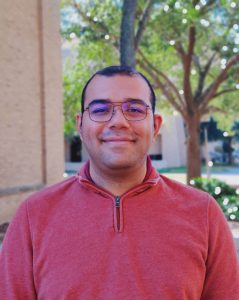
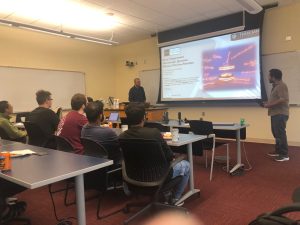

AMO/IQSE/OPTICA student chapter seminar
Speaker: Prof. Thomas Udem, Max-Planck Institute of Quantum Optics, 85748 Garching, Germany
Title: Challenging QED with atomic Hydrogen
Date: Thursday, November 06th (11.30 am)
Abstract: Precise determination of transition frequencies of simple atomic systems are required for a number of fundamental applications such as tests of quantum electrodynamics (QED), the determination of fundamental constants and nuclear charge radii. The sharpest transition in atomic hydrogen occurs between the metastable 2S state and the 1S ground state with a natural line width of only 1.3 Hz. Its transition frequency has been measured with almost 15 digits accuracy using an optical frequency comb and a cesium atomic clock as a reference [1]. A measurement of the Lamb shift in muonic hydrogen is in significant contradiction to the hydrogen data if QED calculations are assumed to be correct [2]. In order to shed light on this discrepancy the transition frequency of one of the broader lines in atomic hydrogen has to be measured with very good accuracy [3,4].
References [1] C. G. Parthey et al., Phys. Rev. Lett. 107, 203001 (2011). [2] A. Antognini et al., Science 339, 417, (2013). [3] A. Beyer et al., Science 358, 79 (2017). [4] A. Grinin et al., Science 370, 1061 (2020).
About the Speaker: Thomas Udem is a Professor of Physics at Ludwig-Maximilians-Universität Munich and a senior scientist in the Laser Spectroscopy Division at the Max Planck Institute of Quantum Optics in Garching, Germany. He received his Ph.D. summa cum laude from Ludwig-Maximilians-Universität Munich in 1997, where his pioneering work on phase-coherent optical frequency measurements in atomic hydrogen laid the foundation for modern optical frequency metrology. Following a postdoctoral fellowship at NIST in Boulder, he returned to the Max Planck Institute, where he has since played a central role in the development of optical frequency combs and their application to high-precision spectroscopy. Professor Udem’s research has significantly advanced the measurement of fundamental constants and contributed to resolving the “proton radius puzzle.” His group’s innovations, including frequency combs for astronomical spectroscopy, are now used at major observatories such as the European Southern Observatory to detect exoplanets. He has co-authored over 200 publications, with several landmark papers in Nature, Science, and Physical Review Letters, and holds multiple international patents in ultrafast laser technology. A fellow of both the American Physical Society and the Optical Society of America, Professor Udem has been recognized with numerous honors including the Röntgen Award, the EPS Prize for Laser Science, and the 2022 IFCS Rabi Award. He continues to teach and mentor students in optics, quantum optics, and spectroscopy, while contributing to international collaborations on time and frequency metrology and precision spectroscopy.
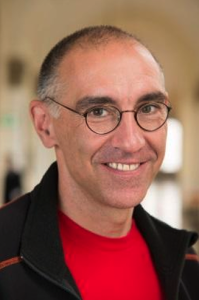
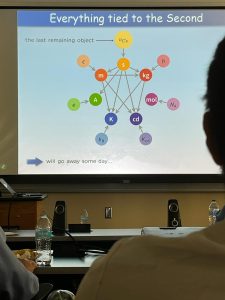
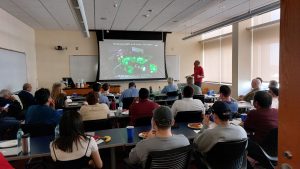
M.Sc. Defense Exam / OPTICA student chapter seminar
Speaker: Amirali Vanakifarahani, Department of Physics and Astronomy, Texas A&M University
Title: Hybrid Pumping Process for High Power (TW-Class) Pulsed Gas Lasers
Date: Thursday, October 23rd (Time: 11.30 am)
Abstract: Laser fusion requires efficient high-power drivers, and excimer lasers (KrF/ArF) are strong candidates. This talk outlines a hybrid pumping framework for high-power excimer lasers that separates plasma sustenance from electron heating: an electron source maintains the discharge while microwave-IR fields reshape the electron energy distribution via inverse Bremsstrahlung into the ~10–20 eV excitation band. I will outline a modeling workflow and computational study aimed at surpassing the ~7% efficiency ceiling of conventional approaches by reducing reliance on e-beam hardware, enabling modular, TW-class, MJ-scale UV systems for inertial confinement fusion. The talk will cover design implications, plasma gain medium optimization, and pathways to experimental validation.
About the Speaker: Amirali (Aryan) Vanakifarahani is a graduate student in Physics at Texas A&M University, where he studies high-power excimer lasers for inertial confinement fusion (ICF). He joined Texas A&M in Spring 2024 and is an alumnus of K. N. Toosi University of Technology. His experience includes internships at CERN and Iran’s Institute for Research in Fundamental Sciences (IPM). He is a 2024 HEEP fellow and 2025 Hagler grad student fellow, working under the mentorship of Professor Gary Eden. He currently serves as Vice President of the Texas A&M OPTICA Student Chapter for the 2025–2026 term. Outside the lab, he enjoys basketball and chess.
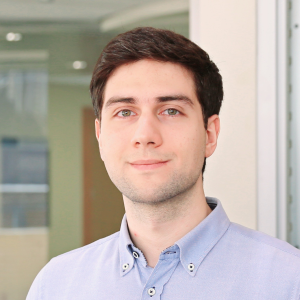
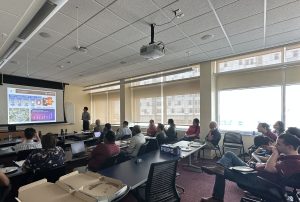
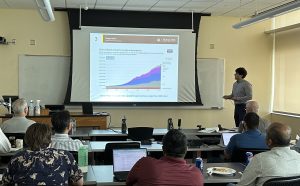
OPTICA student chapter seminar
Speaker: Adnan Alabbar, Department of Physics and Astronomy, Texas A&M University
Title: An Investigation of Temporal Solitons in Nonlinear Systems
Date: Thursday, Oct 09th (11.30 am)
Abstract: Ever since Charles Kao’s studies on reducing losses in optical fibers, the field of nonlinear fiber optics has experienced significant growth. The transmission of information through optical means became one of the dominant methods in telecommunications, replacing many electrical means. However, challenges persist in many neighboring fields, especially nanophotonics, that would address the bottlenecks faced by electrical engineers. In this talk, we’ll discuss optical solitons in nonlinear fiber optics and explore various ways to temper the medium for different engineering and industrial purposes.
About the Speaker: Adnan Alabbar is a Ph.D. student in the Department of Physics and Astronomy at Texas A&M University, studying quantum optics under Professor Girish Agarwal. He earned a Bachelor of Science in Physics from Kuwait University, worked as a research assistant in nuclear astrophysics with Professor M. M. Sharma, and then earned a Master of Science in Optics from the University of Rochester, under Professor Govind Agrawal on optical solitons. He was a Research Associate at the Kuwait Institute for Scientific Research in the Environmental and Life Sciences Research Center before coming to College Station.
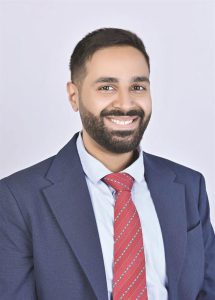
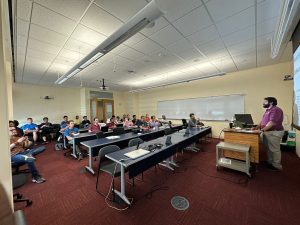
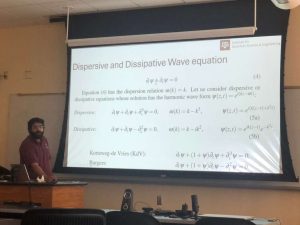
Ph.D. Defense Exam / OPTICA student chapter seminar
Speaker: Reed Nessler, Department of Physics and Astronomy, Texas A&M University
Title: Exact Analytical Eigenfunctions for the Quantum Theory of Laser
Date: Thursday, Sep 25th (11.30 am)
Bio: Reed Nessler is a PhD candidate working under the supervision of Prof. Marlan Scully. Prior to becoming interested in quantum optics, he was trained in mathematics and chemistry.
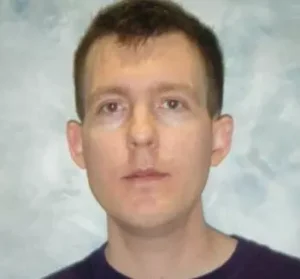
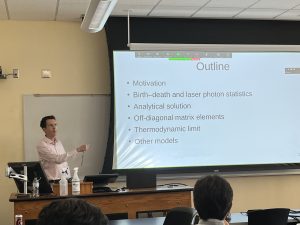
AMO/IQSE/OPTICA student chapter seminar
Speaker: Prof. Dana Z. Anderson, Department of Physics, University of Colorado, Boulder
Title: Maxwell Matter Waves from Gauge Field Theory: Principles and Surprises
Date: Thursday, Sep 18th (10:00 am)
Abstract: A gauge-field theoretical treatment of interacting identical neutral atoms gives rise to a set of matter-wave duals to Maxwell’s equation describing electromagnetic phenomena. The Maxwell duals, in turn, lead to wave equations whose solutions we refer to as “Maxwell matter waves”. These waves are associated with alternating matter currents (AC). Maxwell matter waves are wholly consistent with quantum mechanics, but they are distinct from the more familiar wave solutions of the time-independent Schrödinger equation and exhibit behavior that is substantially different. More than simply a theoretical curiosity, Maxwell matter waves have significant practical applications, particularly in sensing.
About the Speaker:Dana Z. Anderson earned his B.S. degree from Cornell University and his Ph.D. from the University of Arizona, USA. He completed postdoctoral work at the California Institute of Technology. Today, he is a Fellow of JILA and Professor at the University of Colorado, Boulder. In 2015, he co-founded ColdQuanta, where he is CTO. Anderson is a Fellow of OSA and recipient of the R. W. Wood Prize “for pioneering work on photorefractive gain in ring resonators.”


OPTICA student chapter seminar
Speaker: Gabriele Benincasa, Department of Physics and Astronomy, Texas A&M University
Title: Inertial Confinement Fusion: From Breakeven to Future Prospects
Date: Thursday, Sep 11th (11:30 am)
Abstract: The study of Inertial Confinement Fusion (ICF) has recently experienced a strong revival of interest, mostly due to the exceptional milestone achieved at the National Ignition Facility (NIF, USA) on December 5, 2022. For the first time in history, the breakeven condition was reached, with 3.15 MJ of fusion energy produced from a 2.05 MJ laser input, corresponding to an energy gain of 1.5 MJ. This breakthrough demonstrates the viability of ICF as a potential pathway for energy production. Nevertheless, significant challenges remain to be addressed. In this presentation, I will outline the fundamental principles of ICF and discuss the advanced schemes currently under investigation.
About the Speaker: Gabriele Benincasa is a newly admitted Ph.D. student in the Department of Physics and Astronomy at Texas A&M University, where he is pursuing research in Inertial Fusion Energy. He earned a Bachelor of Science in Physics Engineering from Politecnico di Milano (Italy) in July 2021, followed by a Master of Science in Nuclear Engineering from the same institution in 2025. In July 2024, he joined CNR INO (National Research Council of Italy – National Institute of Optics) in Pisa to conduct his master’s thesis on laser–plasma instabilities in ICF. In December 2024, he was awarded a grant by COST (European Cooperation in Science and Technology), which enabled him to participate in Europe’s first experimental campaign on mitigating laser–plasma instabilities with broadband laser pulses at the PHELIX facility, GSI Darmstadt (Germany).
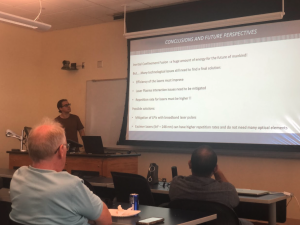
AMO/IQSE/OPTICA student chapter seminar
Speaker: Xiaoyu Nie, Center for Quantum Technologies, National University of Singapore
Title: Ultracold Ground-state 6Li-40K Molecules for Quantum Simulation and Quantum Computation
Date: Monday, Jun 23rd (12:00 pm)
Abstract: Coherent control of rotational transitions in ultracold polar molecules allows for their application in exploring many-body physics, quantum simulation, and quantum information processing. First, I will introduce the pathway toward ultracold (nK) rovibrational ground state molecules and its potential applications.
To prepare dipolar qubits, we perform microwave spectroscopy on the rotational transition of the ground state 6Li-40K molecules and explore differential polarizability of the rotational states. We found two magic points with large detuning and low sensitivities to frequency fluctuations paving the way for achieving long coherence time trapping of the ground state 6Li-40K molecules. I will discuss loading molecules into 3D optical lattices and potential applications in quantum simulations.
About the Speaker: Xiaoyu Nie, Ph.D. student in Center for Quantum Technologies at National University of Singapore, is working on quantum simulation and quantum computation platforms based on ultracold molecules. In 2021, Xiaoyu received Physics bachelor’s degree from Xi’an Jiaotong University, China. He participated in a one-year exchange program at TAMU in 2019-2020 studying ghost imaging and multidimensional ultrafast spectroscopy. During his Ph.D. career, Xiaoyu studied ultracold molecules in 3D optical lattices, in particular, their long-range dipolar interactions which lead to advances in quantum simulation and computation.
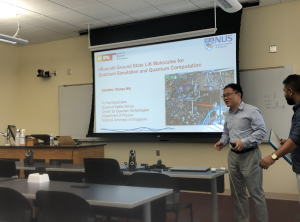
Fall 2024 – Seminars



